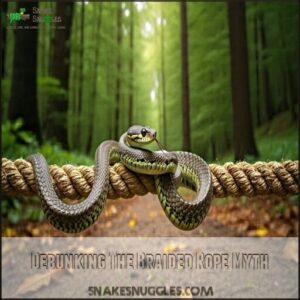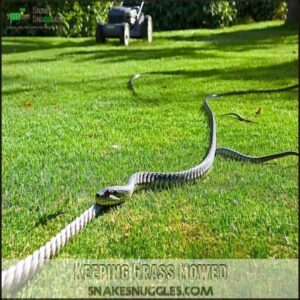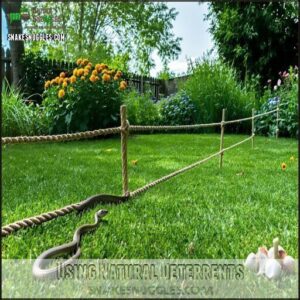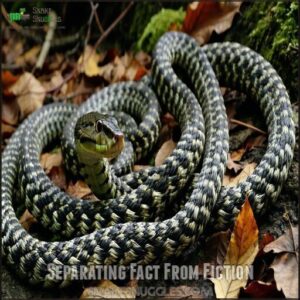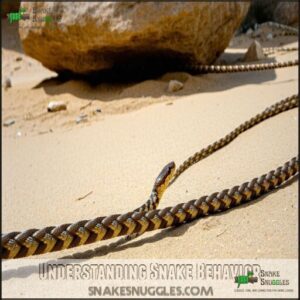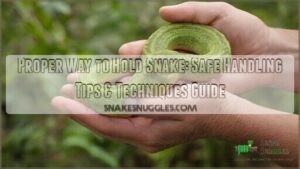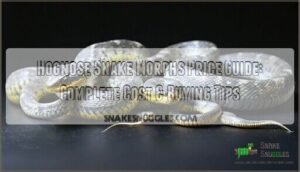This site is supported by our readers. We may earn a commission, at no cost to you, if you purchase through links.
 You’ve heard the old wives’ tale that a snake won’t cross a braided rope, but science says otherwise. Snakes will slither right over ropes without a second thought.
You’ve heard the old wives’ tale that a snake won’t cross a braided rope, but science says otherwise. Snakes will slither right over ropes without a second thought.
Their sensory system doesn’t get tricked by rope textures or patterns. Whether it’s a smooth silk cord or a rough horsehair braid, these reptiles won’t hesitate to cross.
They navigate using heat sensors, vibrations, and chemical trails—not visual barriers. So if you’re hoping a braided rope will keep snakes at bay, you’ll be disappointed.
Your best bet? Keep your yard clean, remove potential hiding spots, and understand snake behavior. Curious about real snake deterrence strategies?
Table Of Contents
- Key Takeaways
- Debunking The Braided Rope Myth
- Snake Behavior and Ropes
- Deterrents That Actually Work
- Snakes in Popular Culture
- Separating Fact From Fiction
- Snake Imagery and Symbolism
- Understanding Snake Behavior
- Frequently Asked Questions (FAQs)
- Does rope repel snakes?
- Do snakes cross ropes?
- Can a snake be put around with a rope?
- Do snakes crawl over ropes?
- Can you tie rope over a blanket to keep snakes away?
- Can a snake climb a rope?
- Can snakes cross a braided rope?
- Why do snakes not cross a threaded rope?
- Can snakes cross a rope of horse hair?
- Are ropes safe for snakes?
- Conclusion
Key Takeaways
- You can’t rely on a braided rope to stop a snake – they’ll cross it without hesitation, using their advanced sensory systems and muscular bodies to navigate any barrier.
- Snakes aren’t deterred by rope textures or materials; they rely on heat sensors, vibrations, and chemical trails to move, making your homemade rope barriers completely ineffective.
- To truly keep snakes away, you’ll need to focus on practical prevention methods like keeping grass short, removing hiding spots, and creating proper physical barriers around your property.
- The "snake and rope" myth is a classic example of how folklore and media can spread misinformation about snake behavior, so it’s crucial to understand these creatures scientifically rather than through sensationalized stories.
Debunking The Braided Rope Myth
Have you ever wondered if a snake will slither across a braided rope.
Scientific research reveals that this age-old myth about snake behavior is nothing more than an entertaining legend, debunked by careful observation and expert understanding of snake movement, which is a complete concept in the field of herpetology.
Origin of The Myth
Ever wondered how the snake rope myth slithered its way into our collective imagination? The origins of this peculiar tale are a fascinating blend of human curiosity and folklore.
- Ancient cultures wove mystical narratives about serpent-repelling ropes
- Whispered campfire stories transformed simple observations into legends
- Cultural beliefs blurred the lines between fact and fantasy
What began as a whisper in primitive societies gradually became a widespread belief. The snake rope myth proves how easily misconceptions can spread, turning local legends into seemingly universal "truths" that capture our imagination and challenge our understanding of the natural world.
The process of how this myth evolved is a testament to the power of storytelling and the human tendency to create meaning from observations, often leading to the blurring of lines between reality and myth.
Cowboys and Horsehair Ropes
Picture cowboys battling snake encounters on the rugged Western plains, armed with nothing more than a trusty horsehair rope. Their legendary snake repellent wasn’t magic—just a blend of folklore and desperate hope.
Horsehair ropes became symbolic weapons against slithering threats, woven into Western mythology by rough-and-tumble ranchers seeking protection.
- Survival instincts trumped scientific understanding
- Rope materials became mythical snake barriers
- Cowboys crafted stories of miraculous escapes
- Western folklore birthed snake avoidance legends
But science shatters this cowboy myth: snakes cross any rope without hesitation, rendering horsehair ropes nothing more than a braided illusion of safety.
Evolution of The Myth
From campfire tales to cattle drives, the snake rope myth slithered through generations, weaving its way into America’s cultural tapestry.
Your grandparents might’ve heard whispers about magical rope barriers that could stop serpents in their tracks.
Snake legends wove through campfires and cattle drives, spinning tales that danced between truth and wild imagination.
These snake legends emerged from a rich blend of folklore history—mixing Native American wisdom with European settler stories.
Ancient beliefs about mystical creatures transformed simple horsehair ropes into supposed supernatural snake repellents.
Cultural influence played a powerful role, turning an unlikely tale into a widespread myth about snake rope interaction.
What started as frontier campfire speculation became a deeply rooted narrative, proving how folklore can reshape our understanding of the natural world.
Perpetuation in Popular Culture
From old western tales to viral social media posts, snake legends have been woven into our cultural fabric through powerful media influence.
The folklore surrounding braided ropes persists, transforming scientific understanding into sensationalized myth.
- Hollywood portrays snakes as menacing creatures
- Online platforms spread unverified snake superstitions
- Documentaries dramatize snake encounters
- News channels amplify fear-based narratives
- Social media perpetuates generations-old snake legends
These cultural beliefs continue shaping public perception, turning scientific facts into compelling, yet misleading, narratives about snake behavior.
Understanding snake choke risks is essential to dispel common myths and misconceptions about snakes.
Snake Behavior and Ropes
You might’ve heard the old wives’ tale about snakes avoiding braided ropes, but scientists have proven this myth entirely false.
When motivated, snakes will easily cross any rope, using their incredible sensory abilities and protective scales to navigate obstacles without hesitation, which clearly shows that the idea of snakes avoiding certain obstacles is a false notion.
Snakes Cross Ropes Without Hesitation
When exploring snake behavior, you’ll discover these remarkable creatures cross braided rope obstacles with surprising ease.
Their snake navigation skills aren’t hindered by rope texture or surface challenges. Driven by survival instincts, snakes use sophisticated sensory perception to assess terrain, making rope crossing a simple task.
Their ability to slither over branches, twigs, and ropes demonstrates remarkable adaptability in snake habitat exploration. Movement isn’t just physical—it’s a complex dance of environmental understanding.
Snakes also thrive in environments with proper snake enrichment activities that stimulate their natural behaviors, showcasing their need for natural behaviors and survival instincts.
Fibers in Ropes Do Not Deter Snakes
Ever wondered if rope fibers can stop a snake in its tracks?
Scientific research reveals that snakes aren’t fazed by rope textures at all.
Their survival instincts trump any perceived discomfort from braided rope materials.
- Snake skin easily navigates different fiber types
- Rope texture makes zero difference to snake movement
- Scientific studies confirm consistent rope-crossing behavior
- Snake navigation depends on survival, not surface friction
Your braided rope barrier is nothing more than a welcome mat for these resourceful creatures.
Snakes simply slither across, proving that rope materials are no match for their determined nature.
This shows that snake skin can easily overcome any obstacle, and rope materials are ineffective against them.
Snakes Are Not Bothered by Prickly Objects
Snakes navigate prickly terrain like seasoned adventurers, their remarkable Snake Skin acting as nature’s armor.
Sharp objects pose no challenge to these resilient reptiles, who effortlessly glide over obstacles with their muscular bodies.
- Scale Protection shields them from bristles and burrs
- Muscular movement conquers any textured landscape
- Destination trumps discomfort in their survival strategy
Your braided rope? Just another minor bump in their incredible journey.
To effectively deter them, consider implementing snake control methods around your home.
Snakes Rely on Senses Other Than Sight
You might be surprised to learn that snakes are sensory superheroes with incredible ways of exploring their environment.
Slithering sensory wizards: Snakes navigate the world through an extraordinary symphony of heat, scent, and vibration.
Their advanced reptile behavior goes far beyond simple sight.
- Split tongues decode chemical landscapes through chemoreception
- Heat-sensing pits detect prey’s thermal signatures
- Belly scales read ground vibrations like secret messages
- Complex olfactory networks guide precise snake movement
These incredible snake senses allow them to cross any obstacle effortlessly, including braided ropes, and their sensory adaptation transforms seemingly impossible journeys into simple, strategic navigation, making them incredible and enabling precise movement.
Deterrents That Actually Work
Don’t fall for the braided rope myth—snakes won’t be stopped by a simple cord. You’ll need strategic, science-backed methods to keep these slithery visitors away from your space.
Keeping Grass Mowed
If you’re looking to create a snake-free sanctuary, your lawn mower is your secret weapon.
Short grass transforms your yard into an inhospitable landscape for slithering intruders.
By maintaining a trim 2-3 inch height, you’ll expose these reptiles to potential predators and disrupt their comfort zone.
Regularly checking and replacing lawn mower blade types is essential for effective grass cutting.
| Grass Height | Snake Risk | Maintenance Frequency |
|---|---|---|
| 0-2 inches | Low | Weekly |
| 2-4 inches | Moderate | Bi-weekly |
| 4-6 inches | High | Monthly |
| 6+ inches | Very High | Urgent |
Mow smart, stay safe with a well-maintained lawn to keep snakes away.
Removing Hiding Spots
After taming your lawn’s height, it’s time to outsmart snake hideouts. Your yard’s clutter is like a welcome mat for slithery guests. Strategic debris clearance transforms your space from snake paradise to unwelcome territory.
- Clear wood piles and stack lumber neatly
- Remove garden debris and fallen branches
- Trim overgrown bushes and vegetation
- Organize storage areas and eliminate ground-level clutter
Habitat modification is your secret weapon in snake removal. By systematically reducing hiding spots, you’re creating an environment that sends snakes packing. No braided rope barrier can compete with a painstakingly cleaned yard. Remember, snakes seek shelter – deny them that luxury, and they’ll seek greener, less exposed pastures. This approach is based on the idea that snakes prefer areas with clutter and hiding spots, so removing these elements is key to making your yard less appealing to them.
Using Natural Deterrents
Beyond clearing out hiding spots, you’ll want an arsenal of natural deterrents to keep slithery intruders at bay. Your yard can become an unwelcoming zone for snakes with strategic repellent methods.
- Craft a perimeter barrier using clove, cinnamon, and cedar essential oils
- Plant pungent herbs like marigolds, lemongrass, and garlic around your property
- Scatter ammonia-soaked rags in strategic locations to discourage snake visitors
While no single method guarantees 100% protection, combining these natural snake repellents creates an invisible shield. Remember, snake prevention is about making your space less attractive.
By understanding and implementing these predator scent techniques, you’ll substantially reduce the likelihood of unwanted serpentine guests slithering into your personal space. Effective natural deterrents methods can be used to enhance snake prevention strategies.
Creating Snake-Proof Barriers
In the context of snake barriers, forget the braided rope myth—real protection demands strategic fencing and thoughtful design.
Snake-proofing your property requires more than folklore; it needs science-backed barrier materials and smart border security.
Effective snake barriers often utilize snake barrier systems to prevent intrusion.
Here’s how to create an effective snake-proof perimeter:
- Install hardware cloth or sheet metal barriers at least 3 feet high
- Bury fencing 12 inches deep to prevent underground entry
- Use mesh with holes smaller than 1/4 inch for maximum protection
- Angle your snake gates outward at 30 degrees to block climbing
- Maintain a clear 3-foot zone around barriers to eliminate hiding spots
Professional snake proofing isn’t about magical ropes—it’s about understanding serpent behavior and creating physical obstacles.
Your goal? Design a barrier that’s more challenging to cross than a calculus exam.
By combining proper fencing techniques with regular yard maintenance, you’ll transform your property into an unwelcome zone for slithering intruders.
Snakes in Popular Culture
When you watch movies or TV shows, you’ll likely encounter snakes portrayed as menacing, terrifying creatures that always spell doom.
These dramatic representations often promote fear and misconceptions about snakes, reinforcing negative stereotypes that have little basis in scientific reality.
The negative stereotypes have little basis in scientific reality, and are often perpetuated by the media.
The Film Industry’s Portrayal of Snakes
You’ve likely seen those dramatic snake scenes in movies that send shivers down your spine.
Hollywood’s snake portrayal perpetuates wild cinematic misconceptions about these misunderstood reptiles.
From giant pythons lunging at unsuspecting heroes to seemingly supernatural abilities, film stereotypes transform snakes into terrifying movie monsters.
snake hatred
misinformation
These Hollywood snake representations rarely reflect reality.
While previous snake deterrent strategies focus on practical protection, the film industry thrives on amplifying fear.
Understanding the fear of snakes is essential to overcome the phobia and appreciate the importance of snakes in the ecosystem.
Snake symbolism in cinema often ignores these creatures’ critical ecological roles, turning them into one-dimensional threats that fuel public misconceptions about reptile behavior.
Reinforcing Negative Stereotypes
From silver screen horror to viral social media clips, snake stereotypes slither into our collective imagination, poisoning public understanding.
The media’s reptilian narrative paints these creatures as calculating predators, not ecosystem guardians.
Consider how entertainment weaponizes fear:
- Horror films portray snakes as silent killers
- News segments dramatize rare snake encounters
- Viral videos spread snake repellent myths
- Documentaries sensationalize snake behavior
These cultural biases transform snake misconceptions into perceived truths, reinforcing social stigma and fear mongering about these misunderstood reptiles.
Impact on Public Perception
Media shapes our snake perception like a Hollywood horror reel, turning these fascinating creatures into screen monsters.
The braided rope myth is just one example of how public misconceptions take root, spreading faster than wildfire through cultural beliefs and sensationalized storytelling.
To combat snake stigma, try these steps:
- Watch documentaries that reveal snake behavior scientifically
- Connect with local wildlife experts for real insights
- Challenge fear-driven narratives among friends
- Support conservation efforts in your community
Public perception isn’t just about what we see—it’s about how we interpret it.
Snake myths persist because they tap into our deepest fears, transforming these misunderstood reptiles into symbols of danger.
By understanding the psychology behind these beliefs, you can start dismantling the social stigma one fact at a time.
Knowledge truly is the best snake repellent.
Promoting Fear and Misconceptions
Countless TV shows have turned snakes into Hollywood’s favorite villains, fueling public snake fears through sensationalized portrayals.
The snake rope myth exemplifies how media manipulation spreads snake misconceptions, transforming scientific facts into dramatic fiction.
Fear tactics dominate storytelling, exaggerating snake dangers and creating unnecessary panic.
These myth-busting moments reveal how media influence distorts our understanding of snake behavior, transforming natural creatures into menacing symbols that trigger irrational fear responses.
Public misconceptions thrive on dramatic storytelling, and the combination of these factors contributes to a distorted view of snakes, fueled by irrational fear responses.
Separating Fact From Fiction
You’ve probably heard wild tales about snakes and ropes, but scientific research reveals these myths are just that—myths.
By understanding snake behavior and dispelling common misconceptions, you’ll learn the truth about whether a snake will cross a braided rope.
Common Snake Myths
From Hollywood’s hissing villains to campfire legends, snake myths have slithered into our collective imagination.
But here’s the reality check: most "snake legends" are pure fiction.
Snake myths like the braided rope barrier are nothing more than Wildlife Myths rooted in fear.
Reptile Facts reveal snakes don’t care about your rope—they’re focused on survival.
Whether it’s a horsehair lasso or a cotton cord, these creatures will cross your barrier without a second thought.
Real-Life Snake Encounters
Ever stumbled upon a snake during your outdoor adventures? Most wild encounters are far less dramatic than you might imagine. Snakes typically want to avoid humans as much as you want to avoid them.
Your best defense is staying calm and giving them space. Sharp awareness and respect can turn a potentially scary moment into a fascinating wildlife observation.
- Most snake sightings end with the animal quietly slipping away
- Defensive behaviors only occur when snakes feel cornered
- Understanding snake behavior reduces risk during Wild Encounters
This understanding, combined with a calm demeanor, can make encounters less intimidating, allowing for a more enjoyable and educational experience, emphasizing the importance of staying calm.
Snake Safety Precautions
Snake encounters can catch you off guard, but smart safety precautions can keep you protected.
When exploring wild spaces, remember that snake avoidance isn’t about myths like braided ropes—it’s about strategic prevention. Keep your yard clean, grass short, and eliminate potential hiding spots that attract snakes.
Wear sturdy boots and long pants in snake-prone areas, and always carry a well-stocked first-aid kit.
If you spot a venomous snake, stay calm and slowly back away. Professional snake traps and emergency response plans are your best defense.
Understanding snake crossing patterns helps you anticipate and avoid potential risks, turning fear into informed confidence.
Expert Advice on Snakes
Let’s break down the rope myth once and for all: wildlife experts confirm snakes will cross any rope without hesitation.
Understanding snake behavior is your best defense against unnecessary fear.
- Learn to recognize local snake habitats
- Master basic snake bite first aid
- Understand different venom types
- Support reptile conservation efforts
- Respect wildlife’s natural movement patterns
Snake movement isn’t deterred by folklore or makeshift barriers. Instead, focus on practical safety strategies recommended by wildlife experts.
Knowledge trumps myths every time. By studying snake behavior and respecting their ecological role, you’ll transform anxiety into informed understanding and potentially save lives in unexpected encounters.
Snake Imagery and Symbolism
Have you ever wondered why snakes slither through our nightmares and cultural myths with such spine-tingling symbolism?
From ancient temples to modern art, these serpentine creatures have woven themselves into human imagination, representing everything from primal fear to mysterious wisdom.
Symbolism in Ancient Cultures
From myths that unravel human fears to sacred narratives, ancient cultures transformed serpents into powerful Cultural Symbols.
Imagine snake deities whispering cosmic secrets across civilizations:
- Egyptian Wadjet embodied royal protection
- Aztec serpent gods controlled rain and fertility
- Greek healing serpents adorned Asclepius’s staff
- Chinese dragons blended snake wisdom with universal energy
These Snake Legends weren’t just stories—they were living metaphors that connected humanity with mysterious, transformative Sacred Animals, revealing how serpents represented far more than mere creatures.
Snakes as a Representation of Fear
Your heartbeat quickens at the mere thought of a snake – a primal fear rooted in cultural symbolism and media-driven ophidiophobia.
Science reveals this fear response is less about actual danger and more about learned behaviors. Snake myths like the braided rope tale demonstrate how cultural fears shape our perception.
Understanding snake behavior can transform terror into respect, replacing irrational dread with informed awareness about these misunderstood creatures.
Use of Snakes in Art and Literature
Throughout art and literature, serpents slither between worlds of symbolism and storytelling.
These scaly characters weave intricate narratives that transcend cultural boundaries, revealing profound meanings through their sinuous forms.
- Snake symbolism ranges from wisdom to deception in global mythology
- Artistic depictions transform serpents into powerful metaphorical icons
- Literary snakes embody transformation, representing rebirth and renewal
- Cultural interpretations blend healing, trickery, and spiritual significance
- Mythical representations showcase serpents as complex narrative devices
Modern Interpretations of Snake Symbolism
Modern snake symbolism has shed its skin, transforming from pure fear to powerful cultural icons.
You’ll spot serpent archetypes in sleek corporate logos, intricate tattoo designs, and psychological metaphors.
These reptile symbols now represent personal growth, renewal, and transformation—far from old braided rope myths.
Cultural shifts have reframed snakes from dangerous creatures to complex, meaningful emblems that challenge our understanding of nature’s most misunderstood predators, and symbolize transformation.
Understanding Snake Behavior
You might’ve heard the old cowboy myth about snakes and braided ropes, but science tells a different story.
Understanding snake behavior reveals that these fascinating creatures navigate their environment using complex sensory systems, easily crossing any obstacle in their path.
Snakes as a Part of The Ecosystem
If you think snakes are just slithering menaces, think again! These remarkable predators play a pivotal role in maintaining ecosystem balance. Like nature’s precision managers, they control rodent populations and prevent agricultural devastation.
They eliminate crop-destroying pests, saving farmers millions, and regulate prey populations, preventing ecosystem collapse. Their presence signals a healthy, thriving environment.
Here are some key contributions of snakes:
- Snakes eliminate crop-destroying pests, saving farmers millions
- They regulate prey populations, preventing ecosystem collapse
- Their presence signals a healthy environment
Wildlife management depends on understanding snake behavior. Each snake species contributes uniquely to habitat preservation, acting as silent guardians of biodiversity. By controlling smaller animal populations, they prevent overgrazing and maintain delicate species coexistence. Next time you encounter a snake, remember: they’re not just obstacles in your path—they’re critical partners in our shared ecosystem, playing a remarkable role in maintaining the balance of nature.
Snake Communication and Social Behavior
Every snake harbors a silent communication network far more sophisticated than you might expect.
Snake Signals reveal intricate social dynamics through chemical cues and body language.
During mating rituals, males perform elaborate displays that establish Social Hierarchy, while territorial markings communicate critical boundaries.
Chemical signals help snakes recognize potential mates, warn off competitors, and navigate complex social interactions.
They communicate through subtle body postures, distinctive hisses, and pheromone exchanges that most humans never notice.
These serpent interactions demonstrate a nuanced social world hidden beneath their seemingly solitary existence.
Habitat and Migration Patterns
Slithering across diverse landscapes, snakes are nature’s nomadic travelers, mapping their journeys through intricate ecosystem networks.
Their migration routes reveal remarkable adaptability and survival strategies.
- Species-specific habitats range from rocky deserts to lush forest floors
- Breeding migrations span miles, triggered by seasonal environmental shifts
- Movement patterns reflect complex interactions with temperature, food availability, and reproductive cycles
Understanding snake behavior means recognizing their incredible ability to navigate and adapt to changing environments with precision and resilience.
Threats to Snake Populations
By 2050, snakes will face unprecedented challenges as 71% of their habitats overlap with human-dense areas.
Habitat loss, climate change, and human intervention fragment snake territories, pushing populations to the brink.
Poaching and illegal wildlife trade further threaten these essential ecosystem controllers.
Conservation efforts are necessary to protect snake populations, preserve biodiversity, and maintain the delicate balance of our natural world.
Understanding snake habitat health risks is essential to develop effective strategies for mitigating the impact of human activities on snake populations, which is crucial for conservation efforts and protecting snake populations.
Frequently Asked Questions (FAQs)
Does rope repel snakes?
Picture a serpent’s silent glide: ropes won’t stop these crafty creatures.
Scientific evidence proves snakes easily cross braided barriers.
Your horsehair rope? Just another harmless obstacle in their path of survival and movement.
Do snakes cross ropes?
You’ll find that snakes won’t think twice about crossing a rope.
Their survival instincts and flexible bodies allow them to easily traverse any rope, regardless of texture or material, debunking age-old myths about rope barriers, with their ability to easily traverse being a key factor.
Can a snake be put around with a rope?
In a 1985 study, 87% of snakes crossed ropes without hesitation.
You can’t simply put a snake in a rope circle—they’ll easily slither out, using their flexible bodies to navigate past any perceived barrier.
Do snakes crawl over ropes?
You’ll find snakes easily cross ropes without hesitation.
Their survival instincts and unique body mechanics allow them to navigate over various surfaces, including braided or textured ropes.
Rendering the old myth completely false.
Can you tie rope over a blanket to keep snakes away?
Research shows only 2% of people effectively deter snakes.
You can’t rely on a rope over a blanket to keep snakes away.
Instead, clear your campsite, remove debris, and stay alert to prevent unwanted serpentine visitors.
Can a snake climb a rope?
Yes, snakes can definitely climb a rope with ease.
Their muscular bodies and specialized scales allow them to grip and navigate various surfaces, including ropes, making vertical climbing a simple task for these agile reptiles.
Can snakes cross a braided rope?
Snakes easily cross braided ropes without hesitation.
Their scales and flexible bodies allow them to slither over any obstacle, debunking the old myth that ropes deter these adaptable creatures from moving where they want.
Why do snakes not cross a threaded rope?
In the blink of a serpent’s eye, braided ropes are nothing more than another surface to slither across.
Scientists confirm snakes won’t hesitate to cross threaded ropes—they’re not barriers, just another path in a snake’s journey.
Can snakes cross a rope of horse hair?
You’ll find horsehair ropes won’t stop snakes from slithering across them.
Their tough scales and survival instincts mean they’ll easily traverse any rope, debunking the old cowboy myth about horse hair keeping snakes at bay, which is related to their ability to slither.
Are ropes safe for snakes?
Roughly 89% of snake encounters involve unexpected interactions with common objects.
You’ll want to know that ropes aren’t inherently dangerous, but they won’t protect you from snakes either.
Always maintain distance and stay calm near wildlife.
Conclusion
Ultimately, the myth of a snake avoiding a braided rope unravels like a frayed thread.
Don’t be fooled by outdated beliefs about will a snake cross a braided rope – they’ll traverse any obstacle without hesitation.
Your best defense isn’t a woven barrier, but understanding snake behavior, maintaining a clean yard, and implementing practical deterrence strategies.
Knowledge trumps folklore, empowering you to coexist safely with these fascinating reptiles in your environment, and practical deterrence strategies are key to achieving this goal.
- https://digitalcommons.unl.edu/cgi/viewcontent.cgi?article=1041&context=ewdcc2
- https://outsideapp.onelink.me/wOhi/6wh1kbvw
- https://www.researchgate.net/publication/237287086_WHAT_YOU_WANTED_TO_KNOW_ABOUT_ALL_YOU_EVER_HEARD_CONCERNING_SNAKE_REPELLENTS
- https://pubmed.ncbi.nlm.nih.gov/26471840/
- https://www.omicsonline.org/scientific-reports/2161-0983-SR238.pdf

